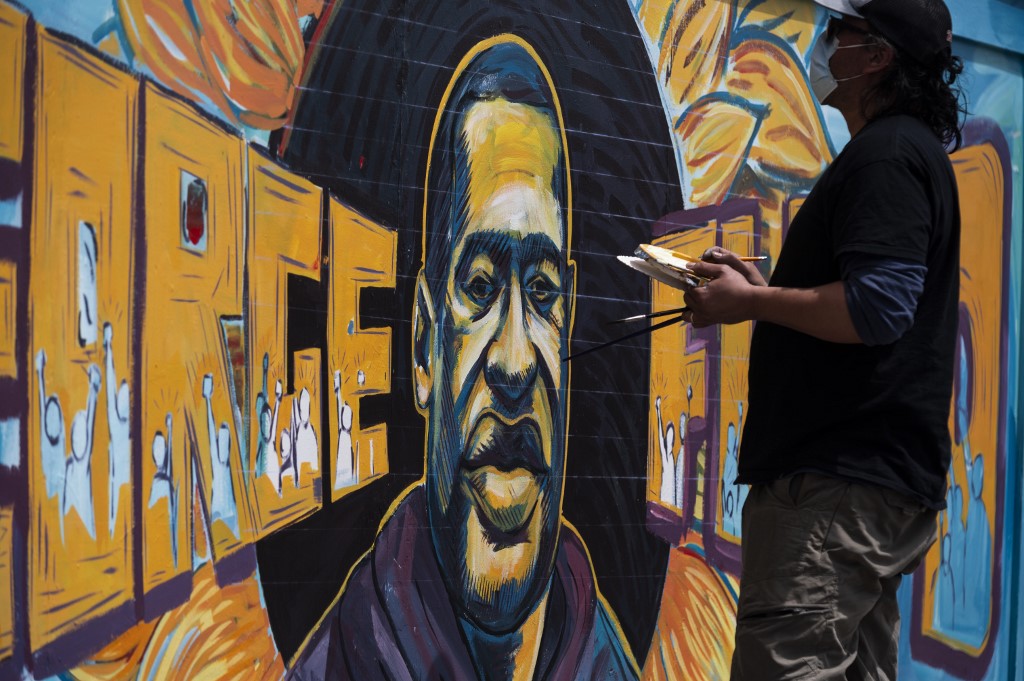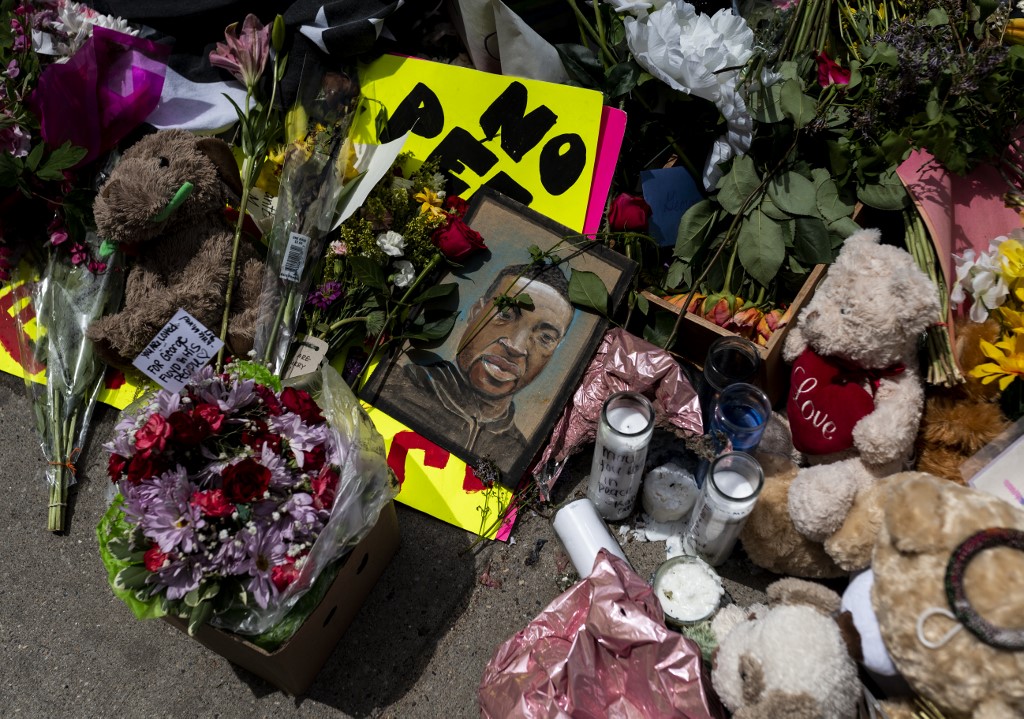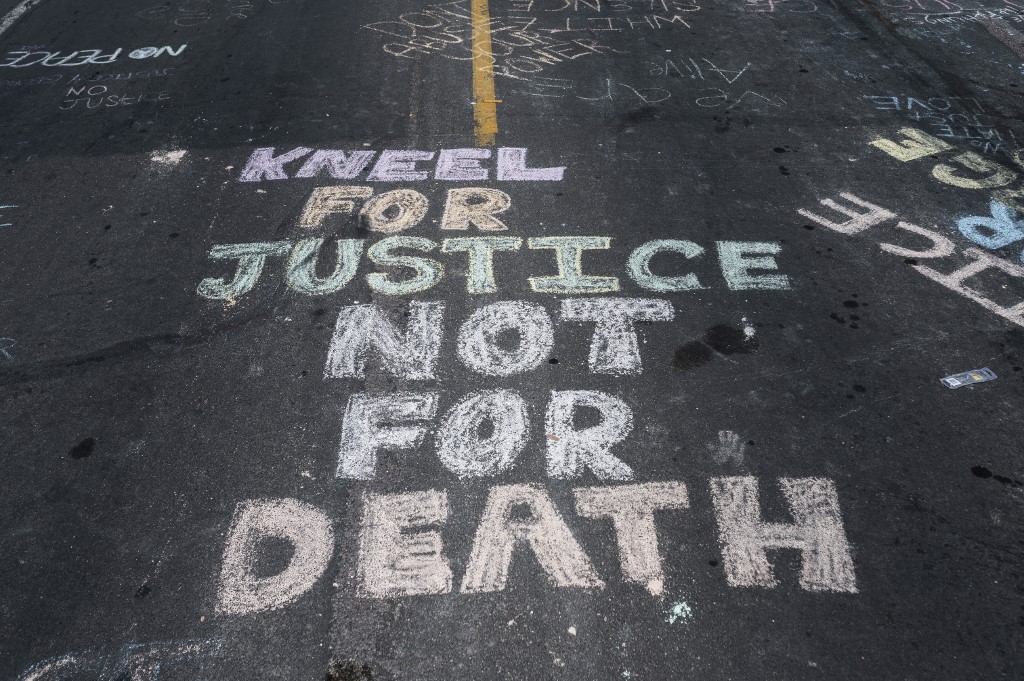Spot where George Floyd died now impromptu forum in Minneapolis

A group of artists paint a mural of George Floyd on the wall outside of Cup Foods, where Floyd was killed in police custody, on May 28, 2020 in Minneapolis, Minnesota. People have gathered at the site since Floyd was killed earlier this week. Stephen Maturen/Getty Images/AFP
MINNEAPOLIS — George Floyd is surrounded by the names of other police brutality victims in a colorful mural that now looms over the spot where he died, located in a rapidly gentrifying Minneapolis neighborhood.
Hundreds of people passed under his gaze Saturday, stopping to pay their respects with a bouquet or written message, and also at a microphone set up at what has become something of a public forum — frequented by a diverse array of mourners, united if by nothing else their pain.
“We are George, we can’t breathe,” the crowd chanted, repeating some of the 46-year-old African American’s last words as he lay dying under an officer’s knee that pressed into his neck for nearly nine minutes until well after he was motionless.
On Friday the white officer was charged with one count of third-degree murder — unintentionally causing a death — and one count of negligent manslaughter.
Standing beneath the mural with signs reading “Charge all four,” and “Jail all racist killer cops,” mourners said they wanted the other three officers who were present to be arrested as well.
Article continues after this advertisement
MINNEAPOLIS, MN – MAY 28: A memorial lies outside the Cup Foods, where George Floyd was killed in police custody, on May 28, 2020 in Minneapolis, Minnesota. Rev. Al Sharpton was joined by Gwen Carr, the mother of Eric Garner, and spoke at the site of Floyd’s death about the need to hold police officers accountable for their actions. Stephen Maturen/Getty Images/AFP
Here, in broad daylight, speech is intended to be peaceful, in contrast with the looting and burning that has taken place during protests which have unfolded at night since Floyd’s death.
Article continues after this advertisementThe microphone was thus quickly snatched from a young man who began to pontificate on black citizens’ constitutional right to bear arms.
But Christina Gonzalez, a 33-year-old New Yorker, quickly came to his defense: “When they pull the mic from that brother for saying something like that, I feel like I have to speak on it.”
‘It’s just draining’
Mixed together in the crowd were blacks, whites, young and old — one man was so enraged by Gonzalez’s comments that he began insulting her before being gently pushed away.
“We’re emotional, we are the melting pot — more like a salad, because we don’t really blend well together, everybody’s coming from different places,” Gonzalez said, noting that some in the crowd had experienced police violence themselves, making them particularly sensitive.

MINNEAPOLIS, MN – MAY 28: “Kneel for Justice not for Death” is written on the road outside the Cup Foods, where George Floyd was killed in police custody, on May 28, 2020 in Minneapolis, Minnesota. People have gathered at the site since Floyd was killed earlier this week. Stephen Maturen/Getty Images/AFP
Alex Washington, a 37-year-old municipal worker, said he has been apprehended for biking on a sidewalk and even for running fast while crossing the street.
“I can’t tell you how many times I’ve been put in the back of police cars and I have a perfectly clean record,” he said.
“To walk in your own neighborhood and feel hated, it’s just draining. I’m sick and tired of feeling drained by hatred in my own community,” he said.
Nonetheless, he felt the diversity of people who had come to pay respects to Floyd was “so beautiful.”
Keira, who did not wish to give her last name, said the broad support was comforting.
“I’m here because I no longer fear for my life as a black person. I feel comfortable now knowing that I got support from the community,” she said, hoping that the unity would last.
Tom Steller, a 65-year-old white pastor who drives Lyft in his spare time, wants to believe that is possible.
“People are just coming together, grieving together, praying together and it shows we can live together in a community even if we’re from different peoples and different faiths,” he said.
In the middle of the crowd Tyron Carter, a former artist, hoped to unite participants by shouting a universally understood refrain: “Momma!” he cried over and over, hugging a silhouette in a white dress.
“Momma, Momma,” Floyd could be heard saying, as he lay dying.